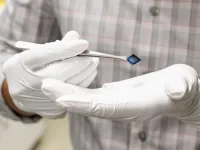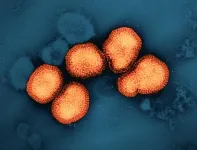(Press-News.org) The feel of a cat’s fur can reveal some information, but seeing the feline provides critical details: is it a housecat or a lion? While the sound of fire crackling may be ambiguous, its scent confirms the burning wood. Our senses synergize to give a comprehensive understanding, particularly when individual signals are subtle. The collective sum of biological inputs can be greater than their individual contributions. Robots tend to follow more straightforward addition, but Penn State researchers have now harnessed the biological concept for application in artificial intelligence (AI) to develop the first artificial, multisensory integrated neuron.
Led by Saptarshi Das, associate professor of engineering science and mechanics at Penn State, the team published their work on September 15 in Nature Communication.
“Robots make decisions based on the environment they are in, but their sensors do not generally talk to each other,” said Das, who also has joint appointments in electrical engineering and in materials science and engineering. “A collective decision can be made through a sensor processing unit, but is that the most efficient or effective method? In the human brain, one sense can influence another and allow the person to better judge a situation.”
For instance, a car might have one sensor scanning for obstacles, while another senses darkness to modulate the intensity of the headlights. Individually, these sensors relay information to a central unit which then instructs the car to brake or adjust the headlights. According to Das, this process consumes more energy. Allowing sensors to communicate directly with each other can be more efficient in terms of energy and speed — particularly when the inputs from both are faint.
“Biology enables small organisms to thrive in environments with limited resources, minimizing energy consumption in the process,” said Das, who is also affiliated with the Materials Research Institute. “The requirements for different sensors are based on the context — in a dark forest, you’d rely more on listening than seeing, but we don’t make decisions based on just one sense. We have a complete sense of our surroundings, and our decision making is based on the integration of what we’re seeing, hearing, touching, smelling, etcetera. The senses evolved together in biology, but separately in AI. In this work, we’re looking to combine sensors and mimic how our brains actually work.”
The team focused on integrating a tactile sensor and a visual sensor so that the output of one sensor modifies the other, with the help of visual memory. According to Muhtasim Ul Karim Sadaf, a third-year doctoral student in engineering science and mechanics, even a short-lived flash of light can significantly enhance the chance of successful movement through a dark room.
“This is because visual memory can subsequently influence and aid the tactile responses for navigation,” Sadaf said. “This would not be possible if our visual and tactile cortex were to respond to their respective unimodal cues alone. We have a photo memory effect, where light shines and we can remember. We incorporated that ability into a device through a transistor that provides the same response.”
The researchers fabricated the multisensory neuron by connecting a tactile sensor to a phototransistor based on a monolayer of molybdenum disulfide, a compound that exhibits unique electrical and optical characteristics useful for detecting light and supporting transistors. The sensor generates electrical spikes in a manner reminiscent of neurons processing information, allowing it to integrate both visual and tactile cues.
It’s the equivalent of seeing an “on” light on the stove and feeling heat coming off of a burner — seeing the light on doesn’t necessarily mean the burner is hot yet, but a hand only needs to feel a nanosecond of heat before the body reacts and pulls the hand away from the potential danger. The input of light and heat triggered signals that induced the hand’s response. In this case, the researchers measured the artificial neuron’s version of this by seeing signaling outputs resulted from visual and tactile input cues.
To simulate touch input, the tactile sensor used triboelectric effect, in which two layers slide against one another to produce electricity, meaning the touch stimuli was encoded into electrical impulses. To simulate visual input, the researchers shined a light into the monolayer molybdenum disulfide photo memtransistor — or a transistor that can remember visual input, like how a person can hold onto the general layout of a room after a quick flash illuminates it.
They found that the sensory response of the neuron — simulated as electrical output — increased when both visual and tactile signals were weak.
“Interestingly, this effect resonates remarkably well with its biological counterpart — a visual memory naturally enhances the sensitivity to tactile stimulus,” said co-first author Najam U Sakib, a third-year doctoral student in engineering science and mechanics. “When cues are weak, you need to combine them to better understand the information, and that’s what we saw in the results.”
Das explained that an artificial multisensory neuron system could enhance sensor technology's efficiency, paving the way for more eco-friendly AI uses. As a result, robots, drones and self-driving vehicles could navigate their environment more effectively while using less energy.
“The super additive summation of weak visual and tactile cues is the key accomplishment of our research,” said co-author Andrew Pannone, a fourth-year doctoral student in engineering science and mechanics. “For this work, we only looked into two senses. We’re working to identify the proper scenario to incorporate more senses and see what benefits they may offer.”
Harikrishnan Ravichandran, a fourth-year doctoral student in engineering science and mechanics at Penn State, also co-authored this paper.
The Army Research Office and the National Science Foundation supported this work.
END
Making AI smarter with an artificial, multisensory integrated neuron
The neuron, developed by Penn State researchers, processes visual and tactile input together
2023-09-15
ELSE PRESS RELEASES FROM THIS DATE:
Scientists take next big step in understanding genetics of schizophrenia
2023-09-15
Genetically speaking, we are individuals different from each other because of slight variations in our DNA sequences – so-called genetic variants – some of which have dramatic effects we can see and comprehend, from the color of our eyes to our risk for developing schizophrenia – a debilitating psychiatric condition affecting many millions worldwide. For several years, scientists have studied the entire genomes of thousands of people – called genome-wide association studies, or GWAS – to find approximately 5,000 genetic variants associated with schizophrenia.
Now, ...
RIT collaboration with global team confirms, disproves distant galaxies
2023-09-15
Rochester Institute of Technology scientists have once again used data from the James Webb Space Telescope (JWST) as part of the Cosmic Evolution Early Release Science (CEERS) Survey to change the way we think about the universe and its distant galaxies.
Jeyhan Kartaltepe, associate professor in the School of Physics and Astronomy, and Rebecca Larson, postdoctoral research associate, co-authored a paper, “Confirmation and refutation of very luminous galaxies in the early Universe,” published in Nature confirming ...
In major breakthrough, researchers close in on preeclampsia cure
2023-09-15
Researchers from Western and Brown University have made groundbreaking progress towards identifying the root cause and potential therapy for preeclampsia.
The pregnancy complication affects up to eight per cent of pregnancies globally and is the leading cause of maternal and fetal mortality due to premature delivery, complications with the placenta and lack of oxygen.
The research, led by Drs. Kun Ping Lu and Xiao Zhen Zhou at Western, and Drs. Surendra Sharma and Sukanta Jash at Brown, has identified ...
Facebook's design makes it unable to control misinformation
2023-09-15
WASHINGTON (September 15, 2023) – As misinformation flourished online during the Covid-19 pandemic, a number of platforms announced policies and practices aimed at combating the spread of misinformation. Did those efforts work?
New research published today in Science Advances suggests that the Covid-19 vaccine misinformation policies of Facebook, the world’s largest social media platform, were not effective in combating misinformation. The study, led by researchers at the George Washington University, found that Facebook’s efforts were undermined by the core design features ...
Study shows replanting logged forests with diverse mixtures of seedlings accelerates restoration
2023-09-15
Twenty-year experiment finds that active replanting beats natural recovery for restoring logged tropical forests.
The higher the diversity of replanted tree species, the more quickly canopy area and biomass recovered.
Results emphasize the importance of preserving biodiversity in pristine forests and restoring it in recovering logged forest.
Satellite observations of one of the world’s biggest ecological experiments on the island of Borneo have revealed that replanting logged forests with diverse mixtures of seedlings can significantly accelerate their recovery. The results have been published today in the journal Science Advances.
The ...
NIH clinical trial of universal flu vaccine candidate begins
2023-09-15
Enrollment in a Phase 1 trial of a new investigational universal influenza vaccine candidate has begun at the National Institutes of Health’s Clinical Center in Bethesda, Maryland. The trial is sponsored by the National Institute of Allergy and Infectious Diseases (NIAID), part of the NIH, and will evaluate the investigational vaccine for safety and its ability to elicit an immune response.
Currently available seasonal influenza (or “flu”) vaccines are effective at preventing specific strains of influenza. Each year, the vaccines are re-evaluated and changed to best match the strains of flu predicted to be the most dominant in the upcoming flu ...
UMass Amherst neuroscientist aims to advance knowledge of human brain development by mapping the sea slug brain
2023-09-15
A University of Massachusetts Amherst neuroscientist has been awarded a $3.1 million grant from the National Institute of Neurological Disease and Stroke to advance knowledge on human brain development by using an unusual subject: the brain of the sea slug.
This tiny invertebrate is an ideal candidate to study for brain development because it adds a countable number of neurons to its brain – the number increases more than 40-fold in less than eight weeks to a total of about 10,000 neurons – while the animal grows and performs behaviors, ...
No pollen, no seeds
2023-09-15
North Carolina State University researchers have successfully transferred an important gene from one compartment of a plant cell to another to produce tobacco plants that lack pollen and viable seeds, while otherwise growing normally. Their findings could lead to better ways of producing hybrid seeds to maximize crop productivity, or to introduce seedlessness in fruit species lacking the often-desired trait, such as raspberries, blackberries or muscadine grapes.
The researchers began the work in the energy-producing portion of a cell, the mitochondria. In plants, aberrations within the mitochondrial genome can be associated with ...
Hydroelectric power plants in Brazil threaten turtles that depend on rapids, study warns
2023-09-15
A research project supported by FAPESP shows that the construction of new hydroelectric power plants in Brazil’s South region could have an impact on more than 30% of the habitat of Phrynops williamsi, the Williams’ side-necked turtle. The species occurs only in areas of Atlantic Rainforest and Pampa (the grassland biome adjacent to Brazil’s border with Uruguay and Argentina), and is classed as “Vulnerable” (facing a high risk of extinction) by the International Union for Conservation of Nature (IUCN).
An article on the study is published in the Journal of Applied Ecology by ...
NIH awards $13.7 million grant to BU researchers investigating genetics of Alzheimer’s disease
2023-09-15
(BOSTON)—The National Institutes of Health/National Institute on Aging recently awarded a $13.7 million grant to a project led by Boston University Chobanian & Avedisian School of Medicine principal investigators Lindsay Farrer, PhD, chief of biomedical genetics and distinguished professor of genetics, and Richard Sherva, PhD, assistant professor of medicine in biomedical genetics, for research using whole genome sequencing and other approaches to identify genetic factors for Alzheimer disease (AD) in Jews currently living in ...
LAST 30 PRESS RELEASES:
Making lighter work of calculating fluid and heat flow
Normalizing blood sugar can halve heart attack risk
Lowering blood sugar cuts heart attack risk in people with prediabetes
Study links genetic variants to risk of blinding eye disease in premature infants
Non-opioid ‘pain sponge’ therapy halts cartilage degeneration and relieves chronic pain
AI can pick up cultural values by mimicking how kids learn
China’s ecological redlines offer fast track to 30 x 30 global conservation goal
Invisible indoor threats: emerging household contaminants and their growing risks to human health
Adding antibody treatment to chemo boosts outcomes for children with rare cancer
Germline pathogenic variants among women without a history of breast cancer
Tanning beds triple melanoma risk, potentially causing broad DNA damage
Unique bond identified as key to viral infection speed
Indoor tanning makes youthful skin much older on a genetic level
Mouse model sheds new light on the causes and potential solutions to human GI problems linked to muscular dystrophy
The Journal of Nuclear Medicine ahead-of-print tip sheet: December 12, 2025
Smarter tools for peering into the microscopic world
Applications open for funding to conduct research in the Kinsey Institute archives
Global measure underestimates the severity of food insecurity
Child survivors of critical illness are missing out on timely follow up care
Risk-based vs annual breast cancer screening / the WISDOM randomized clinical trial
University of Toronto launches Electric Vehicle Innovation Ontario to accelerate advanced EV technologies and build Canada’s innovation advantage
Early relapse predicts poor outcomes in aggressive blood cancer
American College of Lifestyle Medicine applauds two CMS models aligned with lifestyle medicine practice and reimbursement
Clinical trial finds cannabis use not a barrier to quitting nicotine vaping
Supplemental nutrition assistance program policies and food insecurity
Switching immune cells to “night mode” could limit damage after a heart attack, study suggests
URI-based Global RIghts Project report spotlights continued troubling trends in worldwide inhumane treatment
Neutrophils are less aggressive at night, explaining why nighttime heart attacks cause less damage than daytime events
Menopausal hormone therapy may not pose breast cancer risk for women with BRCA mutations
Mobile health tool may improve quality of life for adolescent and young adult breast cancer survivors
[Press-News.org] Making AI smarter with an artificial, multisensory integrated neuronThe neuron, developed by Penn State researchers, processes visual and tactile input together





